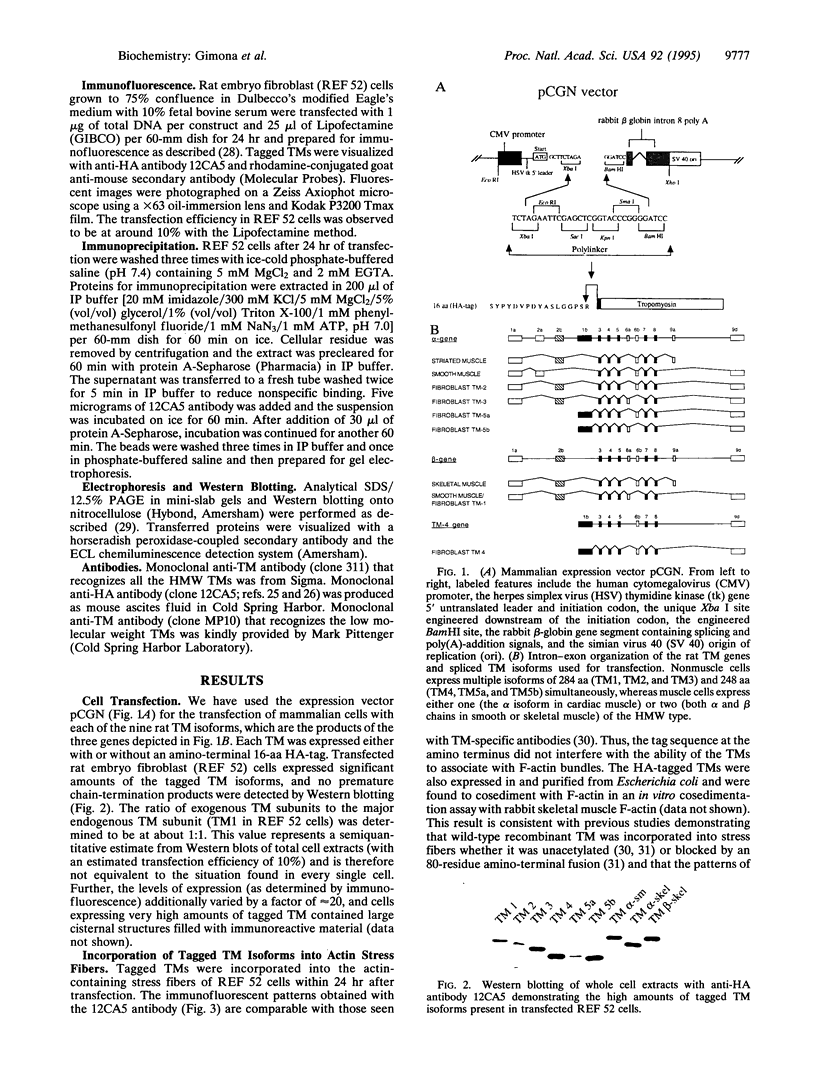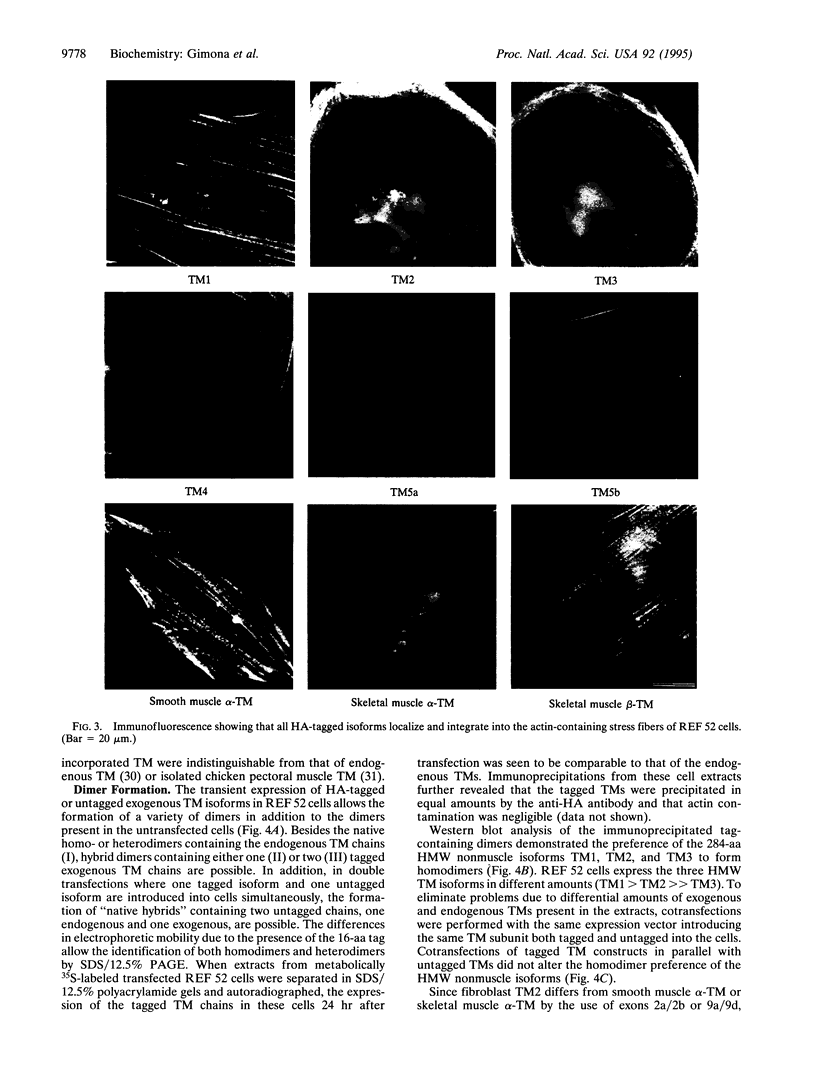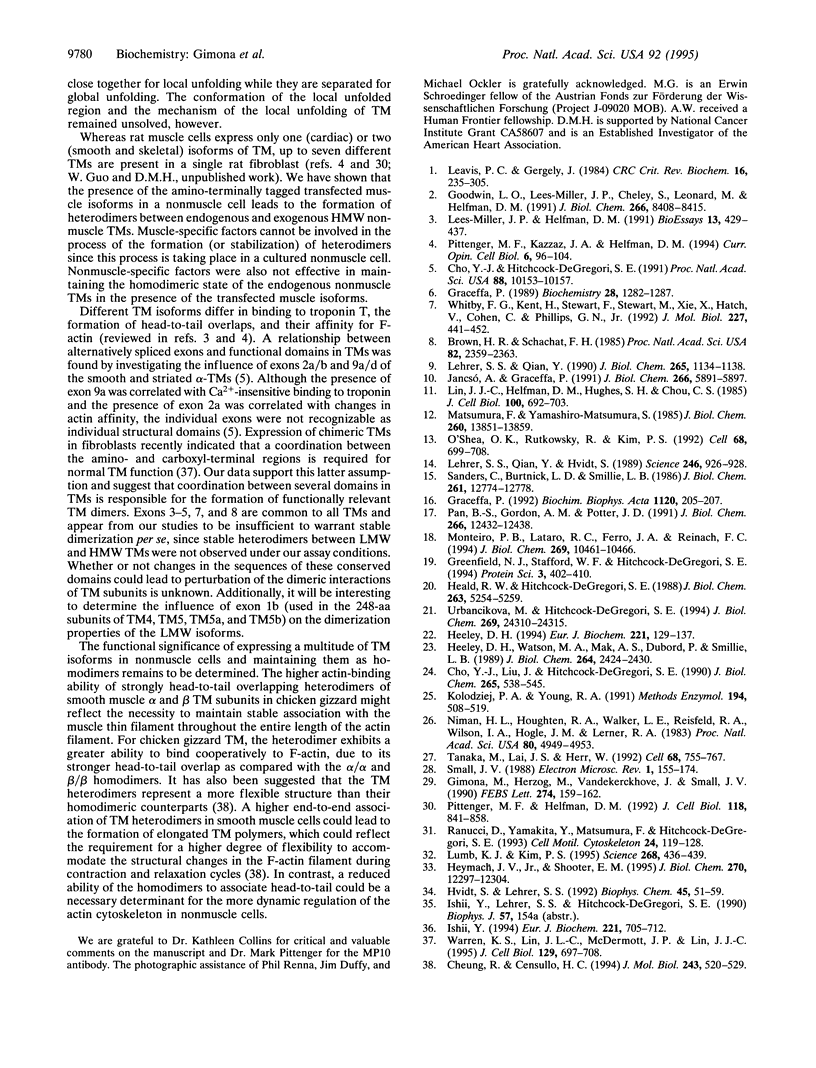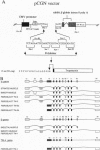Abstract
Tropomyosins consist of nearly 100% alpha-helix and assemble into parallel and in-register coiled-coil dimers. In vitro it has been established that nonmuscle as well as native muscle tropomyosins can form homodimers. However, a mixture of muscle alpha and beta tropomyosin subunits results in the formation of the thermodynamically more stable alpha/beta heterodimer. Although the assembly preference of the muscle tropomyosin heterodimer can be understood thermodynamically, the presence of multiple tropomyosin isoforms expressed in nonmuscle cells points toward a more complex principle for determining dimer formation. We have investigated the dimerization of rat tropomyosins in living cells by the use of epitope tagging with a 16-aa sequence of the influenza hemagglutinin. Employing transfection and immunoprecipitation techniques, we have analyzed the dimers formed by muscle and nonmuscle tropomyosins in rat fibroblasts. We demonstrate that the information for homo- versus heterodimerization is contained within the tropomyosin molecule itself and that the information for the selectivity is conferred by the alternatively spliced exons. These results have important implications for models of the regulation of cytoskeletal dynamics.
Full text
PDF




Images in this article
Selected References
These references are in PubMed. This may not be the complete list of references from this article.
- Brown H. R., Schachat F. H. Renaturation of skeletal muscle tropomyosin: implications for in vivo assembly. Proc Natl Acad Sci U S A. 1985 Apr;82(8):2359–2363. doi: 10.1073/pnas.82.8.2359. [DOI] [PMC free article] [PubMed] [Google Scholar]
- Censullo R., Cheung H. C. Tropomyosin length and two-stranded F-actin flexibility in the thin filament. J Mol Biol. 1994 Oct 28;243(3):520–529. doi: 10.1006/jmbi.1994.1677. [DOI] [PubMed] [Google Scholar]
- Cho Y. J., Hitchcock-DeGregori S. E. Relationship between alternatively spliced exons and functional domains in tropomyosin. Proc Natl Acad Sci U S A. 1991 Nov 15;88(22):10153–10157. doi: 10.1073/pnas.88.22.10153. [DOI] [PMC free article] [PubMed] [Google Scholar]
- Cho Y. J., Liu J., Hitchcock-DeGregori S. E. The amino terminus of muscle tropomyosin is a major determinant for function. J Biol Chem. 1990 Jan 5;265(1):538–545. [PubMed] [Google Scholar]
- Gimona M., Herzog M., Vandekerckhove J., Small J. V. Smooth muscle specific expression of calponin. FEBS Lett. 1990 Nov 12;274(1-2):159–162. doi: 10.1016/0014-5793(90)81353-p. [DOI] [PubMed] [Google Scholar]
- Goodwin L. O., Lees-Miller J. P., Leonard M. A., Cheley S. B., Helfman D. M. Four fibroblast tropomyosin isoforms are expressed from the rat alpha-tropomyosin gene via alternative RNA splicing and the use of two promoters. J Biol Chem. 1991 May 5;266(13):8408–8415. [PubMed] [Google Scholar]
- Graceffa P. Heat-treated smooth muscle tropomyosin. Biochim Biophys Acta. 1992 Apr 8;1120(2):205–207. doi: 10.1016/0167-4838(92)90271-e. [DOI] [PubMed] [Google Scholar]
- Graceffa P. In-register homodimers of smooth muscle tropomyosin. Biochemistry. 1989 Feb 7;28(3):1282–1287. doi: 10.1021/bi00429a050. [DOI] [PubMed] [Google Scholar]
- Greenfield N. J., Stafford W. F., Hitchcock-DeGregori S. E. The effect of N-terminal acetylation on the structure of an N-terminal tropomyosin peptide and alpha alpha-tropomyosin. Protein Sci. 1994 Mar;3(3):402–410. doi: 10.1002/pro.5560030304. [DOI] [PMC free article] [PubMed] [Google Scholar]
- Heald R. W., Hitchcock-DeGregori S. E. The structure of the amino terminus of tropomyosin is critical for binding to actin in the absence and presence of troponin. J Biol Chem. 1988 Apr 15;263(11):5254–5259. [PubMed] [Google Scholar]
- Heeley D. H. Investigation of the effects of phosphorylation of rabbit striated muscle alpha alpha-tropomyosin and rabbit skeletal muscle troponin-T. Eur J Biochem. 1994 Apr 1;221(1):129–137. doi: 10.1111/j.1432-1033.1994.tb18721.x. [DOI] [PubMed] [Google Scholar]
- Heeley D. H., Watson M. H., Mak A. S., Dubord P., Smillie L. B. Effect of phosphorylation on the interaction and functional properties of rabbit striated muscle alpha alpha-tropomyosin. J Biol Chem. 1989 Feb 15;264(5):2424–2430. [PubMed] [Google Scholar]
- Heymach J. V., Jr, Shooter E. M. The biosynthesis of neurotrophin heterodimers by transfected mammalian cells. J Biol Chem. 1995 May 19;270(20):12297–12304. doi: 10.1074/jbc.270.20.12297. [DOI] [PubMed] [Google Scholar]
- Hvidt S., Lehrer S. S. Thermally induced chain exchange of frog alpha beta-tropomyosin. Biophys Chem. 1992 Nov;45(1):51–59. doi: 10.1016/0301-4622(92)87023-c. [DOI] [PubMed] [Google Scholar]
- Ishii Y. The local and global unfolding of coiled-coil tropomyosin. Eur J Biochem. 1994 Apr 15;221(2):705–712. doi: 10.1111/j.1432-1033.1994.tb18783.x. [DOI] [PubMed] [Google Scholar]
- Jancsó A., Graceffa P. Smooth muscle tropomyosin coiled-coil dimers. Subunit composition, assembly, and end-to-end interaction. J Biol Chem. 1991 Mar 25;266(9):5891–5897. [PubMed] [Google Scholar]
- Kolodziej P. A., Young R. A. Epitope tagging and protein surveillance. Methods Enzymol. 1991;194:508–519. doi: 10.1016/0076-6879(91)94038-e. [DOI] [PubMed] [Google Scholar]
- Leavis P. C., Gergely J. Thin filament proteins and thin filament-linked regulation of vertebrate muscle contraction. CRC Crit Rev Biochem. 1984;16(3):235–305. doi: 10.3109/10409238409108717. [DOI] [PubMed] [Google Scholar]
- Lees-Miller J. P., Helfman D. M. The molecular basis for tropomyosin isoform diversity. Bioessays. 1991 Sep;13(9):429–437. doi: 10.1002/bies.950130902. [DOI] [PubMed] [Google Scholar]
- Lehrer S. S., Qian Y. D., Hvidt S. Assembly of the native heterodimer of Rana esculenta tropomyosin by chain exchange. Science. 1989 Nov 17;246(4932):926–928. doi: 10.1126/science.2814515. [DOI] [PubMed] [Google Scholar]
- Lehrer S. S., Qian Y. Unfolding/refolding studies of smooth muscle tropomyosin. Evidence for a chain exchange mechanism in the preferential assembly of the native heterodimer. J Biol Chem. 1990 Jan 15;265(2):1134–1138. [PubMed] [Google Scholar]
- Lin J. J., Helfman D. M., Hughes S. H., Chou C. S. Tropomyosin isoforms in chicken embryo fibroblasts: purification, characterization, and changes in Rous sarcoma virus-transformed cells. J Cell Biol. 1985 Mar;100(3):692–703. doi: 10.1083/jcb.100.3.692. [DOI] [PMC free article] [PubMed] [Google Scholar]
- Lumb K. J., Kim P. S. Measurement of interhelical electrostatic interactions in the GCN4 leucine zipper. Science. 1995 Apr 21;268(5209):436–439. doi: 10.1126/science.7716550. [DOI] [PubMed] [Google Scholar]
- Matsumura F., Yamashiro-Matsumura S. Purification and characterization of multiple isoforms of tropomyosin from rat cultured cells. J Biol Chem. 1985 Nov 5;260(25):13851–13859. [PubMed] [Google Scholar]
- Monteiro P. B., Lataro R. C., Ferro J. A., Reinach F. de C. Functional alpha-tropomyosin produced in Escherichia coli. A dipeptide extension can substitute the amino-terminal acetyl group. J Biol Chem. 1994 Apr 8;269(14):10461–10466. [PubMed] [Google Scholar]
- Niman H. L., Houghten R. A., Walker L. E., Reisfeld R. A., Wilson I. A., Hogle J. M., Lerner R. A. Generation of protein-reactive antibodies by short peptides is an event of high frequency: implications for the structural basis of immune recognition. Proc Natl Acad Sci U S A. 1983 Aug;80(16):4949–4953. doi: 10.1073/pnas.80.16.4949. [DOI] [PMC free article] [PubMed] [Google Scholar]
- O'Shea E. K., Rutkowski R., Kim P. S. Mechanism of specificity in the Fos-Jun oncoprotein heterodimer. Cell. 1992 Feb 21;68(4):699–708. doi: 10.1016/0092-8674(92)90145-3. [DOI] [PubMed] [Google Scholar]
- Pan B. S., Gordon A. M., Potter J. D. Deletion of the first 45 NH2-terminal residues of rabbit skeletal troponin T strengthens binding of troponin to immobilized tropomyosin. J Biol Chem. 1991 Jul 5;266(19):12432–12438. [PubMed] [Google Scholar]
- Pittenger M. F., Helfman D. M. In vitro and in vivo characterization of four fibroblast tropomyosins produced in bacteria: TM-2, TM-3, TM-5a, and TM-5b are co-localized in interphase fibroblasts. J Cell Biol. 1992 Aug;118(4):841–858. doi: 10.1083/jcb.118.4.841. [DOI] [PMC free article] [PubMed] [Google Scholar]
- Pittenger M. F., Kazzaz J. A., Helfman D. M. Functional properties of non-muscle tropomyosin isoforms. Curr Opin Cell Biol. 1994 Feb;6(1):96–104. doi: 10.1016/0955-0674(94)90122-8. [DOI] [PubMed] [Google Scholar]
- Ranucci D., Yamakita Y., Matsumura F., Hitchcock-DeGregori S. E. Incorporation of microinjected mutant and wildtype recombinant tropomyosins into stress fibers in fibroblasts. Cell Motil Cytoskeleton. 1993;24(2):119–128. doi: 10.1002/cm.970240205. [DOI] [PubMed] [Google Scholar]
- Sanders C., Burtnick L. D., Smillie L. B. Native chicken gizzard tropomyosin is predominantly a beta gamma-heterodimer. J Biol Chem. 1986 Sep 25;261(27):12774–12778. [PubMed] [Google Scholar]
- Small J. V. The actin cytoskeleton. Electron Microsc Rev. 1988;1(1):155–174. doi: 10.1016/s0892-0354(98)90010-7. [DOI] [PubMed] [Google Scholar]
- Tanaka M., Lai J. S., Herr W. Promoter-selective activation domains in Oct-1 and Oct-2 direct differential activation of an snRNA and mRNA promoter. Cell. 1992 Feb 21;68(4):755–767. doi: 10.1016/0092-8674(92)90150-b. [DOI] [PubMed] [Google Scholar]
- Urbancikova M., Hitchcock-DeGregori S. E. Requirement of amino-terminal modification for striated muscle alpha-tropomyosin function. J Biol Chem. 1994 Sep 30;269(39):24310–24315. [PubMed] [Google Scholar]
- Warren K. S., Lin J. L., McDermott J. P., Lin J. J. Forced expression of chimeric human fibroblast tropomyosin mutants affects cytokinesis. J Cell Biol. 1995 May;129(3):697–708. doi: 10.1083/jcb.129.3.697. [DOI] [PMC free article] [PubMed] [Google Scholar]
- Whitby F. G., Kent H., Stewart F., Stewart M., Xie X., Hatch V., Cohen C., Phillips G. N., Jr Structure of tropomyosin at 9 angstroms resolution. J Mol Biol. 1992 Sep 20;227(2):441–452. doi: 10.1016/0022-2836(92)90899-u. [DOI] [PubMed] [Google Scholar]







